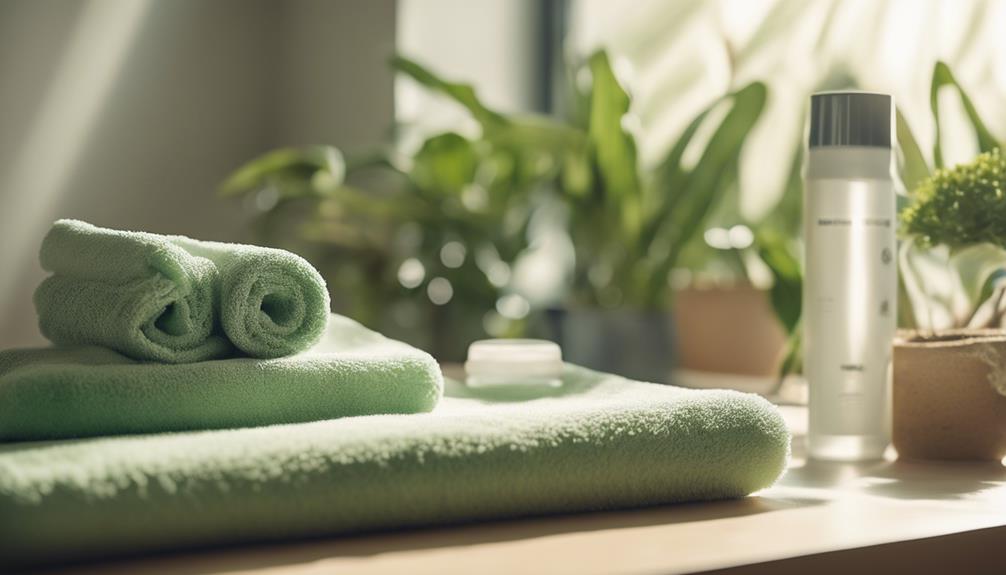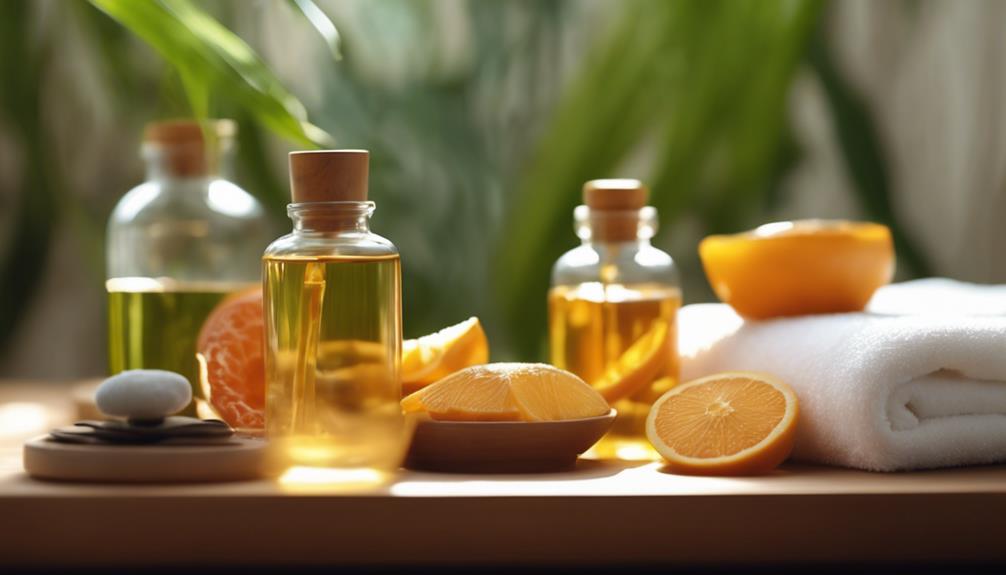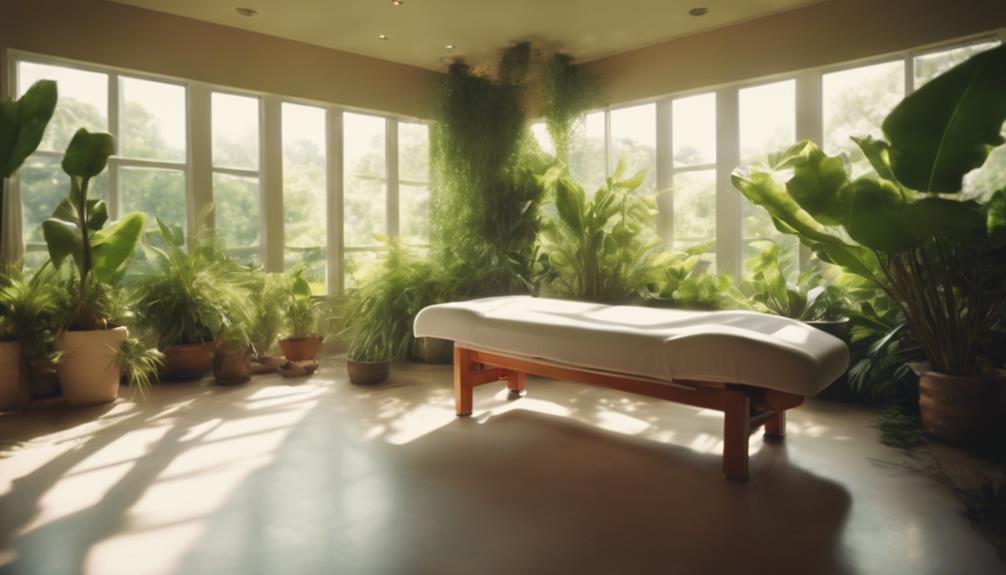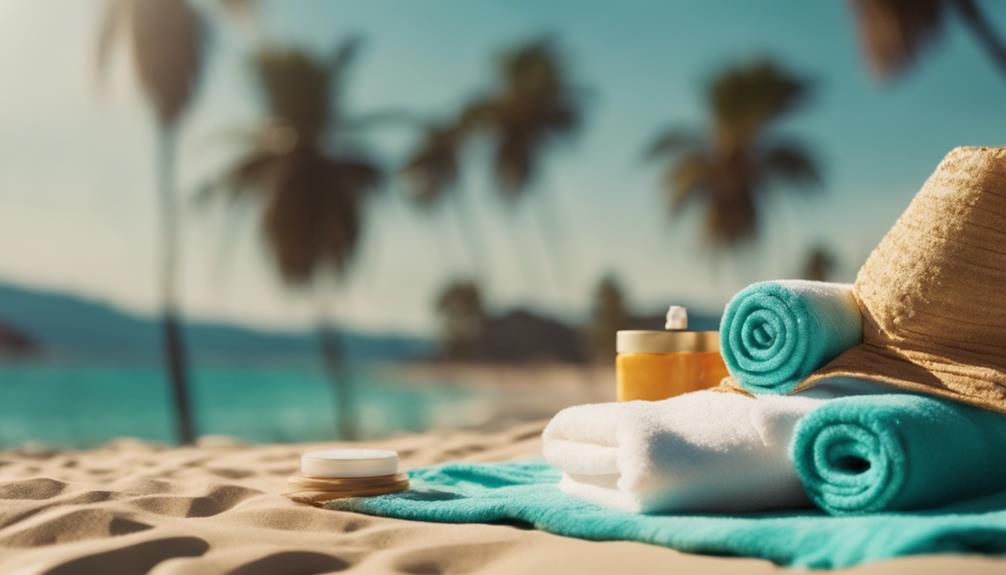Want to keep your tanning beds fresh and the planet happy? Start by using a simple mix of vinegar and water to wipe down after each use—it's a total game-changer! Make it a routine; clean weekly for those stubborn spots. Use soft sponges to protect those shiny surfaces—no scratches allowed, right? Think sustainable too! Use reusable bottles and bamboo tools to cut down on waste. With a little care, you can create a healthy salon vibe for everyone. And guess what? There's so much more to making eco-friendly choices that'll make you smile!
Key Takeaways
- Use a vinegar and water mixture as a natural disinfectant for cleaning tanning beds effectively while minimizing chemical exposure.
- Opt for biodegradable and eco-friendly cleaning supplies to enhance hygiene and reduce environmental impact.
- Incorporate non-abrasive materials like microfiber cloths and soft sponges to protect tanning bed surfaces during cleaning.
- Store cleaning solutions in reusable spray bottles to cut down on plastic waste and promote sustainability.
Eco-Friendly Cleaning Solutions
When cleaning tanning beds, opt for eco-friendly solutions that protect both your equipment and the environment. You don't need harsh chemicals to get the job done!
Try a simple vinegar and water mix; it's like magic for those stubborn spots. Just combine equal parts vinegar and water, add a few drops of essential oils, and voilà! Your natural disinfectant is ready. Let it sit for a moment to really kick those germs to the curb.
Plus, using biodegradable cleaners means you're being nice to Mother Earth, which is always a win. Just remember to store your cleaners safely, out of reach of kids.
Who knew cleaning could be so green and easy? Happy cleaning, eco-warrior!
Regular Cleaning Routine

Establishing a regular cleaning routine for your tanning beds is key to maintaining hygiene and prolonging their lifespan. You wouldn't want to lay down on a bed that's seen better days, right?
So, make it a habit to clean those beds after every session. A quick wipe down can do wonders! Plus, schedule a deep cleaning once a week to tackle any stubborn buildup. Think of it as giving your tanning beds a spa day.
Using eco-friendly supplies not only protects the planet but also keeps your beds in tip-top shape. Remember, a little effort goes a long way in keeping your tanning beds fresh and inviting.
Who wouldn't want to feel fabulous in a clean space?
Non-Abrasive Materials

Using non-abrasive materials like microfiber cloths and soft sponges is essential for keeping your tanning beds scratch-free and looking great. You don't want to ruin that shiny surface with harsh scrubbers, right?
Microfiber cloths are awesome because they pick up dirt without scratching. Plus, they're super gentle—like a little hug for your tanning bed!
Soft sponges are another fantastic option for a gentle clean. Just remember to pair them with eco-friendly cleaners that are safe for those acrylic surfaces. Your tanning bed deserves some love, too!
Sustainable Accessories

Incorporating sustainable accessories, like reusable spray bottles made from recycled materials, can greatly reduce your environmental impact while cleaning tanning beds.
Why toss single-use bottles when you can grab one that helps Mother Earth? Plus, bamboo cleaning tools aren't just eco-friendly; they look pretty snazzy, too!
Think about it—your cleaning kit can support a green lifestyle while keeping things tidy.
And don't forget to train your staff on these green practices; it's a great way to boost your salon's reputation!
Who doesn't want to be known as the cool, eco-conscious salon in town?
So, let's make cleaning not just effective but also a bit more planet-friendly.
You'll feel good knowing you're doing your part!
Tanning Bed Safety

Regularly inspect tanning beds to minimize malfunction risks and guarantee your safety during sessions. You wouldn't want to be the person who accidentally turns into a lobster, right?
Always wear protective eyewear to shield those peepers from harmful UV rays. And hey, remember to check your skin type; it'll help you figure out how long you should stay in that cozy bed.
Before tanning, make sure your skin is clean and free of lotions—think of it like prepping for a big date!
If you're not feeling the tan vibe, sunless tanning products are a fun, UV-free option. Plus, keep your skin hydrated afterward; nobody wants to deal with dry, flaky skin.
Happy tanning!
Natural Disinfectants

Create your own natural disinfectants using simple ingredients like vinegar and essential oils to effectively clean tanning beds without harsh chemicals.
It's super easy! Just mix equal parts distilled white vinegar and water in a spray bottle, and voilà—your eco-friendly cleaner is ready! You can even add a few drops of your favorite essential oil for a fresh scent. Who doesn't love a bit of lavender while cleaning?
Spray it on the tanning bed, let it sit for a bit, then wipe it down with a soft cloth. It's satisfying, and you're doing your part for the planet!
Plus, you won't have to worry about those nasty chemical fumes. Cleaning can actually be fun, right?
Benefits of Eco-Friendly Practices

Using eco-friendly practices not only helps protect the environment but also enhances the safety and longevity of your tanning beds. You'll feel great knowing you're making a positive impact! Plus, it's easier than you think.
Here are some key benefits:
- Healthier Environment: You reduce harmful chemicals that can harm our planet.
- Safer Spaces: Eco-friendly cleaners are gentler on your skin and the tanning equipment.
- Cost-Effective: Many natural solutions, like vinegar, are budget-friendly and effective!
- Increased Durability: Regular eco-friendly maintenance keeps your tanning beds looking fresh and lasting longer.
Frequently Asked Questions
How Often Should I Replace My Eco-Friendly Cleaning Supplies?
You should replace your eco-friendly cleaning supplies regularly, ideally every three to six months. Check for any signs of degradation or contamination, and guarantee your supplies maintain their effectiveness for safe, efficient cleaning.
Are There Specific Brands of Eco-Friendly Cleaners for Tanning Beds?
You might wonder if all eco-friendly cleaners are safe for tanning beds. Brands like Sunless Solutions and EcoTan offer specialized products that clean effectively without harsh chemicals, ensuring your tanning equipment remains hygienic and environmentally friendly.
Can I Use Essential Oils Directly on Tanning Beds?
You shouldn't use essential oils directly on tanning beds, as they can damage the surface. Instead, mix them with a suitable eco-friendly cleaner for a safe, effective cleaning solution that won't harm your tanning equipment.
What Is the Best Way to Store Cleaning Supplies Safely?
To store cleaning supplies safely, keep them in a locked cabinet out of children's reach. Use original containers and label everything clearly. Make certain the area is cool, dry, and well-ventilated to maintain effectiveness.
How Can I Train Staff on Eco-Friendly Cleaning Practices?
To train your staff on eco-friendly cleaning practices, demonstrate effective techniques visually. Use hands-on workshops, share informative materials, and encourage discussions about the benefits of sustainable cleaning to foster a responsible and engaged team.
Conclusion
By going green with your tanning bed cleaning, you're not just protecting the planet; you're also giving your salon a health boost.
It's like giving your tanning beds a spa day while saving the Earth—talk about a win-win!
Remember, a little effort goes a long way, and your clients will love the fresh vibe.
So grab those eco-friendly supplies, and let's make your salon a shining example of sustainability!










